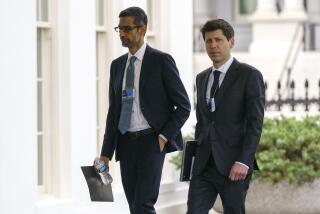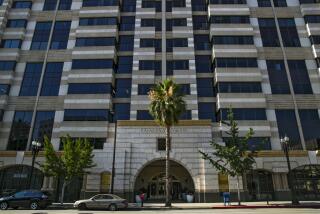Column: The billion-dollar CRISPR patent battle: A case of big money shaping science
- Share via
The 21st century is still young, but it may already have its era-defining patent fight.
The contestants are the University of California and the Broad Institute, a Harvard- and MIT-affiliated research foundation endowed by Los Angeles billionaire Eli Broad. At stake are the rights to a breakthrough gene-editing technology known as CRISPR — and more precisely, to billions of dollars in royalties and license fees likely to flow to whichever claimant prevails before the U.S. Patent and Trademark Office (and in the almost inevitable appeals in court).
“This is a monumental event for patent attorneys, molecular biologists, the PTO, and the world,” patent expert Jacob Sherkow wrote recently on Stanford’s Law and Biosciences blog.
CRISPR — an acronym for the pattern in DNA strands that forms the basis of the technique — allows the cutting and splicing of DNA sequences with unprecedented precision and speed. Applied to animal and plant cells in the lab, researchers have spliced away mutations that cause blindness, made cells resistant to the HIV virus, cured muscular dystrophy in mice, and created wheat strains resistant to fungal diseases.
But that work is just a prelude for potential applications in human biology. These could include cures for complex genetic-related conditions such as Alzheimer’s, diabetes and cancer, along with the more equivocal prospect of making heritable changes in the human genome, “editing” human embryos to eliminate genetic deficiencies or promote desirable traits, with unpredictable long-term ramifications for the species.
The patent case turns on the question of which researchers at the two institutions conceived of the most important CRISPR applications first. UC says it’s a team at its Berkeley lab headed by Jennifer Doudna, with the collaboration of Emmanuelle Charpentier, now of Germany’s Helmholtz Centre for Infection Research. The Broad’s claim is based on the work of its researcher Feng Zhang.
The patent office will be judging the competing positions by an outdated legal standard, making the CRISPR fight not only one of the most consequential in biomedical history but also the last of its kind. In 2013, the patent office changed its rules to a “first-to-file” basis from the old “first-to-invent,” making the U.S. the last major country to do so. The idea was to end disputes that turned on minute interpretations of lab records or personal notes, with costs that arguably disadvantaged small inventors.
Because the initial Doudna and Zhang patent filings predated the change, the old rules apply. But it’s still a complicated chronology. UC filed a broad patent for Doudna, Charpentier and two colleagues in 2013, and the Broad for a dozen patents on behalf of Zheng and several colleagues starting a few months later. But the Broad asked for “fast-track” examination, so its patents got issued before the examination of UC’s more extensive claims was complete.
Both research teams have indicated that they see the patent fight as a distraction. “I remain focused on the science and the exciting applications of the CRISPR ... technology,” Doudna emailed when I asked her about the case.
Other scientists see the battle as a distasteful example of the influence of big money — and the race for Nobel credit — on basic research. “Having prizes and patents involved has transformed what should be one of the greatest success stories for basic research into this nasty, catty fight in which people are behaving poorly,” says Berkeley biologist Michael Eisen, a colleague of Doudna’s and the head of a lab that stands to gain resources if UC wins the patent fight.
He added on his blog: “Neither Berkeley nor MIT should have patents on CRISPR, since it is a disservice to science and the public for academic scientists to ever claim intellectual property in their work.” Indeed, neither the Doudna nor Zhang teams were the first to identify CRISPR or to use it; the history dates back as far as 1987 and involves researchers in Japan, Spain, Chicago, Quebec and other places.
The gold rush underlying the patent battle arises from its potential for reducing the time, complexity and cost of research and development on remedies for genetic disease and on genetically modified plants and animals.
Doudna and Zhang both have been part of that trend: Doudna co-founded one of the first CRISPR-related firms, Caribou Biosciences, which holds an exclusive license to the UC research and has raised $15 million in venture capital. She also is associated with Cambridge-based Intellia Therapeutics, which has raised $85 million in venture capital and also licenses her work. Cambridge-based Editas Medicine, which lists both Doudna and Zhang among its founders, raised about $94 million Feb. 3, in the first initial public offering of 2016. That’s on top of $120 million it raised last year from investors, including Bill Gates and Google, based on its access to the Broad Institute’s patents. The stock gained nearly 14% on its first day of trading, closing at $18.20. Doudna is no longer associated with Editas.
But the rush toward commercialization threatens to obscure more fundamental concerns about how scientists exploit CRISPR. Among the strongest voices urging caution is Doudna, who helped organize a meeting last year in Napa that urged a “pause” before CRISPR moves from the lab into clinical use. Some scientists have gone even further, urging a moratorium on clinical uses of CRISPR that wouldn’t be lifted until the risks of unanticipated consequences are well understood — if ever.
“We should be conscious of the power of the technology, and make responsible decisions about its use going forward,” Doudna told me by email. “This technology has the power to treat or even cure genetic diseases, but there is still much to learn before the technology becomes a viable tool for use in creating heritable genetic changes.”
She may well be correct. But the real question is whether the future of the technology will be guided by the need to learn more, or the opportunity to earn more.
Michael Hiltzik’s column appears every Sunday. His new book is “Big Science: Ernest Lawrence and the Invention That Launched the Military-Industrial Complex.” Read his blog every day at latimes.com/business/hiltzik, reach him at [email protected], check out facebook.com/hiltzik and follow @hiltzikm on Twitter.
More to Read
Inside the business of entertainment
The Wide Shot brings you news, analysis and insights on everything from streaming wars to production — and what it all means for the future.
You may occasionally receive promotional content from the Los Angeles Times.











